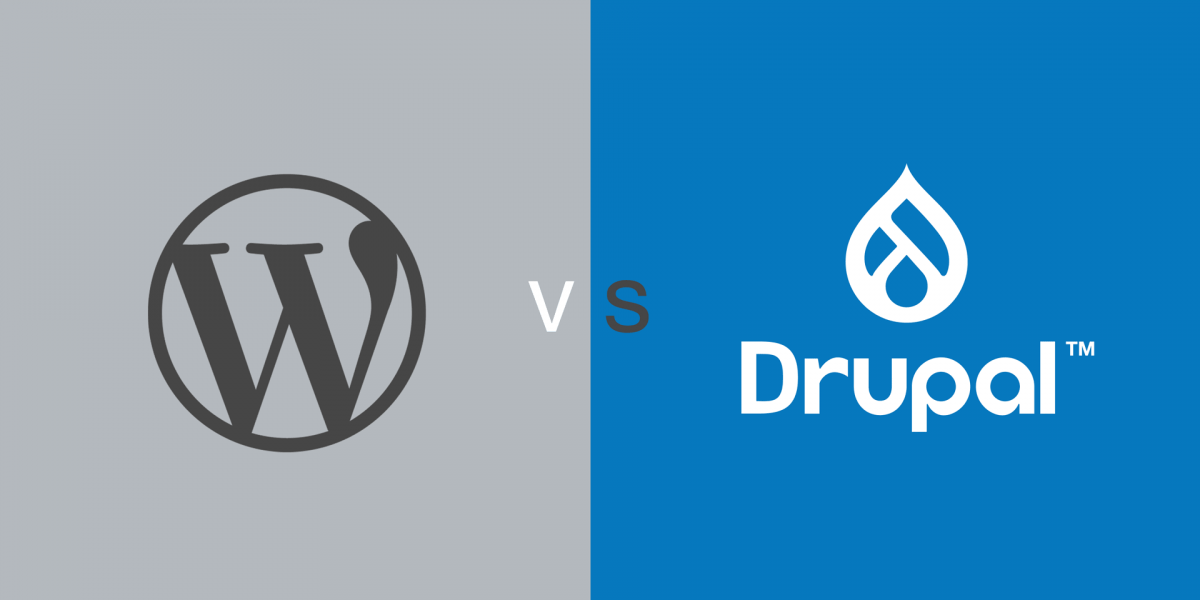DRUPAL VS WORDPRESS FOR HIGHER EDUCATION WEBSITES

DRUPAL VS WORDPRESS FOR HIGHER EDUCATION WEBSITES
You’re about to begin a huge overhaul of your higher education website and one of the first steps is to choose a content management system. It’s probable that Drupal and WordPress have come up in your research, and you may be trying to pick between the two.
Drupal and WordPress are often compared to one another because they’re both open source content management systems. Both have the ability to design clean, responsive websites that are simple for content editors to manage. The functionality of both can be enhanced using third party code. And the code for both is openly available for anyone to use, change, and distribute, meaning there are no licencing fees like there would be with closed source options.
There are a significant number of higher education websites on Drupal; Harvard, Brown, and Oxford University all use the CMS, to name a few. According to Drupal.org, 71% of the top 100 universities use Drupal. And there’s some sound reasoning behind that.
Both WordPress and Drupal have strengths and are well suited for a diverse range of projects. WordPress was primarily built for standalone websites or blogs with minimal variation in content types. Drupal was designed for more intricate, feature-rich websites, like those needed for higher education, that demand extensive interconnectedness between pages or site components.
Here are some factors to consider when choosing between the two content management systems.
COMPLEX ARCHITECTURE
You’re probably in for a challenging project if you decide to rebuild a website for higher education. Your website likely needs a more complex architecture than others; you’ll need various sections that are targeted toward different groups of users, such as prospective students, current students, alumni, faculty, and staff.
Drupal’s ecosystem was built around cases like these. It can handle thousands of users and different content types. Upgrades in Drupal 9 have also resulted in better caching features that make for improved page load times.
WordPress works well for general, standalone marketing sites, but it will struggle with aspects like multiple install profiles, content sharing networks, consistency, maintainability, and connectivity with other parts of the site.
USERS AND PERMISSIONS
A lot of users and permissions are probably required to access your website. Different groups will need to perform different tasks and interact with the site in a variety of ways. You may also have different departmental sites that will need to be managed by different teams while staying consistent with branding guidelines.
Drupal allows for multi-site functionality that can also be centrally managed. You can limit users’ and departments’ capabilities to what they strictly require by assigning them various permissions and roles.
SECURITY
Security flaws can exist in every CMS, even the most robust ones. WordPress might have seen more security difficulties in the past simply because it’s a more popular CMS. WordPress relies heavily on plugins when used for more complex websites, and these plugins are often susceptible to security issues.
WhiteHouse.gov and other federal government websites trust Drupal because it is generally renowned for being a very secure content management system. Drupal has a dedicated security team that receives security issues from the general public and coordinates responses. Issues are resolved as quickly as possible and users are alerted to vulnerabilities through regular announcements. The security team also provides documentation on how to write secure code and how to secure your site. With these practices, you can rest assured that all of your student and faculty data would be protected.
EASE OF USE
When it comes to ease of use, WordPress outperforms Drupal for simpler sites. It is relatively simple to set up and run, even for folks who aren’t very tech aware, as it was designed for simpler, standalone websites. Drupal’s complexity means it has a steep learning curve and takes longer to build.
Although Drupal is a feature-rich CMS that can create more complex sites, it also requires a higher level of technical expertise. To complete your project, you’ll need a team of experts with ample experience, which will probably cost more than a team of WordPress developers.
But the extra price that you pay for a team of experts will pay off in the end when you have a website that is capable of doing everything you need it to. Drupal’s high barrier to entry with respect to module development also means the quality of modules available is higher, and the choices are fewer but more obvious.
WHICH SHOULD YOU CHOOSE?
When it comes down to it, Drupal is likely the better choice between the two. It’s clear that while WordPress has its strengths, Drupal is preferable for more complex websites, such as those needed for higher education.
Drupal provides a strong base to begin rapidly building a complex system. It’s often the CMS of choice for large websites that require significant interconnectivity between different sections. Security is a top concern for the entire community, and it also permits a wide range of user roles and permissions. Its many features make it a great CMS option for websites related to higher education.
Have you ever imagined that hundreds of web applications get created each month? The problem has shifted from “does your company need a web application?” to “how much does a web application development costs?” As we recognize that everything is shifting digital, industries must have a web application.
However, hundreds of articles provide different estimates for a web application development cost which does not give us a clear picture of the actual costs. Everyone wishes it to be so simple, like split-second estimates and time frames. Unfortunately, it is not that simple.

(Source- netleafinsoft.com)
Let’s dive into various factors that impact the web application development costs:
- Scope of project:
The scope of the project allows having the required amount of work to develop the web application. Fulfilling all the characteristics at once will increase the cost of development and impediments.
- Technological complexity:
Implementation of technical complexities will increase the cost of development, whereas regular features are not so expensive.
- UI/UX Design:
If you want to have a customized design to lure your audience, the web development costs will increase. On the other hand, standard templates and themes will need a less expensive UI/UX design.
- Deadlines:
A rush project always means higher costs. If there is a demand to meet tight deadlines, more resources get engaged in a single project. A deadline also means higher risk with effective management and increased costs.
- Non-functional needs:
One of the most non-functional needs for a web development company is the system’s capacity to handle per unit of time. Heavy load systems are always expensive.
- Web development company:
The geographical location plays a crucial role in deciding the web development costs. Web development companies’ charges vary as per the geographical location.
- Engagement model:
The fixed engagement model will increase the development cost, whereas the non-fixed price models will cut your development expenses.
Also, there is a distinction between the charges taken by freelancers and charges by a company like Infozion for web application development.
Compare Web development charge on company rates:
With the similarity in requirements, engagement model, and functionality, the web development cost will range from approximately $10,000 to $5,00,000+.
Here is the reason for the price variance:
- Geographical location:
The geographical location determines the prices of the web development professionals and the extent of their corporate charges. Companies’ prices differ as per the geographical location.
- Industry expertise:
Companies with highly skilled professionals who have expertise in narrow fields are always in high demand. The cost for these expert services becomes higher as they possess special knowledge.
- Company’s goodwill and respected awards:
You should know and be ready to pay more if you want to develop the web application with a company having goodwill, a qualified team, a suitable workplace, and a proven track record.
Well, let us have a look at the statistics regarding approximate web development costs by company sizes (for a mid complexity application- 1500 hours approximately)
Freelancers and startups: $15,000 to $38,000
Small companies: $38,000 to $1,00,000
Mid sized companies: $1,00,000 to $2,25,000
Large companies: $2,25,000 to $5,00,000
It is best to select experienced professionals, as they will benefit your company in the long run. Such experts are not significantly expensive in the market.
Cost evaluation by project complexity:
Now the next stage is to present the web development costs based on project types.
Basic (simple web app):
$5,000 to $15,000+
The basic simple web app includes basic functionalities, minimum content, and limited UI/UX. Examples are:
- Pre-defined template layouts.
- Small online catalogues.
- It includes additional widgets and features to the existing web apps.
Professional (mid-complexity web app):
$15,000 to $60,000+
The professional web applications include more advanced functionalities, a lot of content, and interactive features. Examples are:
- E-commerce stores.
- Market-based web apps
- Modules for existing web apps
Complex web apps:
$60,000 to $2,00,000+
The complex web apps have advanced features like audio/video processing, real-time synchronization, custom animations, third-party integrations, and complex back-end.
Enterprise web apps:
$2,00,000 to $5,00,000+
The enterprise web apps often developed for established companies have various custom features, individual UI/UX designs. Examples are:
- Automated billing systems
- Payment processing apps
- Call centres
- E-mail marketing systems
Innovative web apps:
$5,00,000+
The reason for the higher cost for these web apps lies in their title. These apps are made for large corporations having continuous large cash flows.
These are complicated web apps requiring constant innovation.

(Source- quora.com)
Throw away your doubts:
If you have your project costs estimated, but it does not fit your budget.
It is perfectly fine.
Do not make a hasty decision.
Instead, try to clarify every detail.
When you and the development company clarify the doubt, there will be two options left.
- Quit
- Try to negotiate the price.
On the other hand, if the price is unexpectedly low, try to clarify all the details.
Lower price catches attraction.
However, if you are not tempted to clarify your doubts, you might have the risk of overpaying the prices later.
Note:
The above estimations have approximate figures, and the costs may vary as per the company rates.
Closing summary:
We hope that now you have a basic understanding of various factors included in the web development costs, how the companies determine the prices, and how to clarify the doubts.
Moreover, if you want the precise cost estimation of a web development app, contact the companies directly.
At Infozion, we consider the project estimation cost as a chance to understand customer needs. In turn, we would know if the customers were satisfied with our way of communication, work approach, and prices.
If you are looking for experts to guide you through the process, feel free to contact us.
Our experts will connect with you in 24hrs to save you hassle and time.





